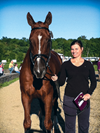Q: I am struggling with keeping my school figures accurate. Circles become egg-shaped, diagonal lines are rarely straight and cutting corners seems normal for me. Could you give me a few tips on how to improve the accuracy of my school figures? I really want to get ready for showing and be prepared as best as possible. —Name witheld by request
A: In my opinion riding accurate figures comes down to focus, planning and attention to detail. It is very important that we ride proactively and not reactively. We have to prepare our horse for what is coming next instead of reacting to what happened a moment ago.

The set-up phase when riding corners, circles, centerlines or diagonals is crucial for the exercise to be successful. When the school figures are done precisely, we get the most out of them. Oftentimes we focus too much on everything but the figure itself. We have to make it a priority and be resolute about the accuracy of the exercise. If we are picky about it, it will improve the connection and overall feeling. It will also give us feedback on how the horse is feeling, what his tendencies are (e.g., is he falling in, falling out, rushing?). Commit to the figure you are riding and don’t compromise.
Before you ride a circle, you have to know which points of the arena or track it should touch, depending on whether it starts at A, C or a letter in the middle of the ring. It is a good idea to walk the circle on foot first. Knowing where to go already puts you ahead of the game. Once these points are established, you have to look up, look ahead and look where you want to be next. Don’t look down at your horse’s neck. Keep your eyes on your circle.
Looking too much ahead will also get you in trouble because your horse will follow your eyes and fall in. Riding into the corner or letting the horse get stuck to the wall are also common mistakes. Circles have no straight lines—you have to remember to keep turning.
Riding a correct diagonal starts with riding a good corner. Corners offer excellent training opportunities. By asking your horse to step into the corner, correctly flexed and correctly bent, you give him a natural opportunity to balance and step more under himself. As I said before, you have to plan in advance and think of the corner before you get there. Once you are in it, it’s too late to affect accuracy.
Use your inside leg to bend your horse’s body and a guarding outside leg behind the girth to prevent the horse’s haunches from swinging out. Remember that you still want your horse straight (hind legs aligned with his front legs) in the bending line.
Just as on the circle, in the corner keep your head and eyes aligned with your horse’s head and don’t look too much ahead, as this will throw your horse off balance, which will result in him falling in.
Think of riding your horse straight down the long side for a longer amount of time. You still have 6 meters from the letter to the actual corner. Use these 6 meters.
If your horse tends to run or cut the corner, this indicates a loss of balance. To help your horse, use walk transitions before the corner, walk through the corner and then trot off again. This will make the horse wait for you. If this exercise helps, you can also use a trot–walk–trot transition before the corner, which will eventually turn into an invisible half halt.
Once you can ride a good corner, your diagonal lines won’t be an issue. Using your eyes to focus yourself on the line ahead will help you to be precise. If you feel your horse drifting off that imaginary line, don’t overreact, just channel him again between your legs and your hands. If you overcorrect your horse with your legs or hands, it will create a drunken line where the horse bounces off your aids like the ball in a pinball machine.
Riding transitions within the diagonal line is a good exercise for all types of horses, both those who tend to run and those who slow down. It will assure you that your horse is in front of your legs and between your aids. Keep your eyes on the letter and don’t let your horse drift out of that line while doing your transitions. Remember that you are committed to that line.

Mica Mabragaña is a USDF bronze, silver and gold medalist as well as a USDF Certified Instructor through Fourth Level. Riding Granada, she qualified to represent Argentina at the WEG in France in 2014. Training horses and riders to Grand Prix, she divides her time between Bedford, New York, and Wellington, Florida.











